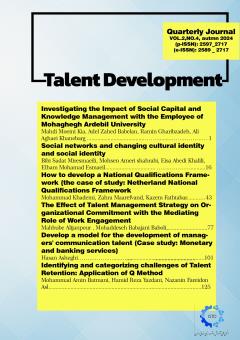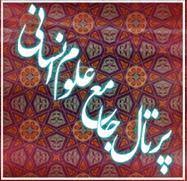About the journal
Recent Articles
-
Open Access Article
1 - Investigating the Impact of Social Capital and Knowledge Management with the Employee of Mohaghegh Ardebil University
Mahdi Moeini Kia Adel Zahed Babelan Ramin Gharibzadeh Ali Aghaei KhanebargIssue 4 , Vol. 2 , Autumn 2024 -
Open Access Article
2 - Social networks and changing cultural identity and social identity
bibi sadat miresmaeili mohsen ameri shahrabi eisa abedi khalili elham mohamad esmaeiliIssue 4 , Vol. 2 , Autumn 2024 -
Open Access Article
3 - How to develop a National Qualifications Framework (the case of study: Netherland National Qualifications Framework)
Mohammad khademi زهرا معارف وند kazem fathtabarIssue 4 , Vol. 2 , Autumn 2024 -
Open Access Article
4 - The Effect of Talent Management Strategy on Organizational Commitment with the Mediating Role of Work Engagement
mohaddeseh babajani baboli mahbube alijanpourIssue 4 , Vol. 2 , Autumn 2024 -
Open Access Article
5 - Develop a model for the development of managers' communication talent (Case study: Monetary and banking services)
hasan asheghiIssue 4 , Vol. 2 , Autumn 2024 -
Open Access Article
6 - Identifying and categorizing challenges of Talent Retention: Application of Q Method
mohammad amin batmani Hamid Reza Yazdani nazanin fareidon aslIssue 4 , Vol. 2 , Autumn 2024
Most Viewed Articles
-
Open Access Article
1 - Identifying methods of creating Learner-content interactions for developing learner engagement in online learning environments
hamed hosseini zarrabi Abasalt Khorasani morteza rezaei zadehIssue 2 , Vol. 2 , Spring 2024 -
Open Access Article
2 - (Validating the Return on Expectations Evaluating Model (ROE
Alireza Dehghani Bijan Abdollahi hossein Abbasian Mohammad Reza BehrangiIssue 3 , Vol. 2 , Summer 2024 -
Open Access Article
3 - Explaining Managerial Factors and Indicators of Talent Development of Iranian Banking Industry Managers
hasan asheghiIssue 1 , Vol. 1 , Winter 2024 -
Open Access Article
4 - The Model of Human Capital Capabilities Evolution in Public Organizations of Iran: The Phenomena Hierarchy Approach
Mehdi Hodaei Seyed Mehdi Alvani Hamid Reza Yazdani Hasan Zarei MatinIssue 2 , Vol. 2 , Spring 2024 -
Open Access Article
5 - The effect of future-oriented talent management on career discovery of medical students: An analysis of the mediating role of organizational knowledge architecture
Reza sepahvand mohammad amin aeinyIssue 2 , Vol. 2 , Spring 2024 -
Open Access Article
6 - Designing a diversity-based talent management model (Grounded theory approach
neda shakoori ali shirazi faribirz rahimnia azar kafashporIssue 2 , Vol. 2 , Spring 2024 -
Open Access Article
7 - Investigating the Relationship between of Myers-Briggs Type Indicator (MBTI) with Transformational Leadership Style in Talent Management Process of National Iranian Oil Company
دکتر مجید سلیمی Mohammad Montakhab YeganehIssue 1 , Vol. 1 , Winter 2024 -
Open Access Article
8 - Redesigning Evaluation and Effectiveness in the Training and Development System of Private Banks: Proposing an Integrated Model
علی دانا Mohammadreza Nili Ahmadabadi Khadijeh Aliabadi Ali Delavar Mohammadali Dehghan DehnaviIssue 3 , Vol. 2 , Summer 2024 -
Open Access Article
9 - Factors Influencing the Selection of Human Capital Compatible with the Fourth Generation Industrial Revolution Using Fuzzy DEMATEL Method
mohammad amin aeinyIssue 3 , Vol. 2 , Summer 2024 -
Open Access Article
10 - The Pattern of Causal Relation of Employees’ Cognitive Empowerment with Quality of Work Life and Organizational Socialization with the Mediating Role of Organizational Learning
akbar amrahi davod ghoronehIssue 1 , Vol. 1 , Winter 2024





